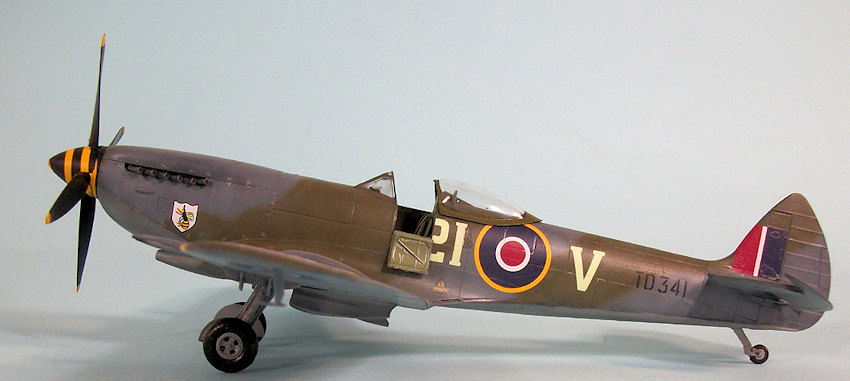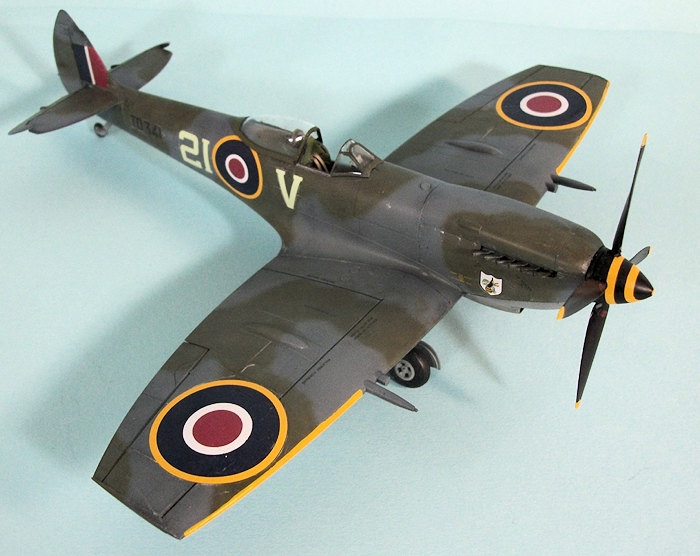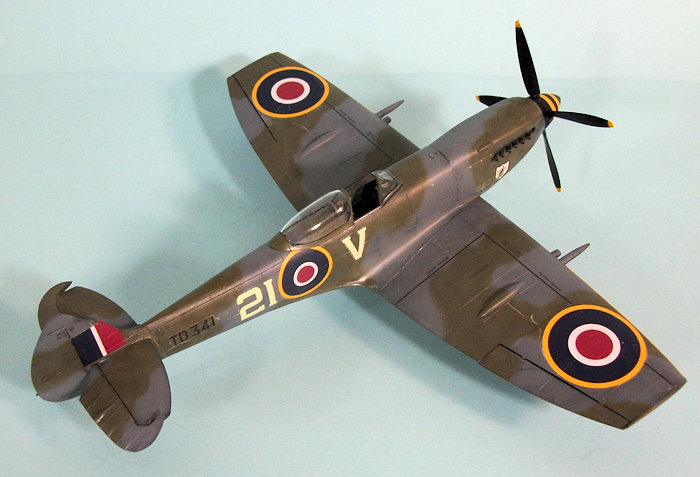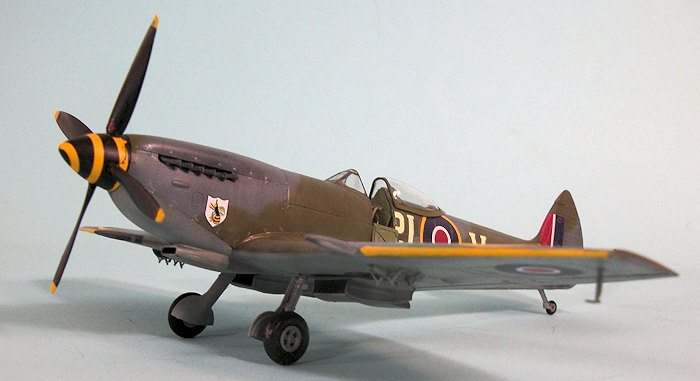
Eduard 1/48 Spitfire XVI 'Lowback'
| KIT #: | 1198 |
| PRICE: | $75.00 SRP |
| DECALS: | Six options |
| REVIEWER: | Tom Cleaver |
| NOTES: | Dual kit boxing |

| HISTORY |
 The Spitfire
XVI is a Mk. IX airframe with a Packard-built Merlin-266 engine. The type began
production in the fall of 1944; however, delivery delays by Packard resulted in
the type not becoming operational until late 1944. The “lowback” version, which
was first developed in the fall of 1944, was not delivered to squadrons until
march 1945 due to these delivery delays.
The Spitfire
XVI is a Mk. IX airframe with a Packard-built Merlin-266 engine. The type began
production in the fall of 1944; however, delivery delays by Packard resulted in
the type not becoming operational until late 1944. The “lowback” version, which
was first developed in the fall of 1944, was not delivered to squadrons until
march 1945 due to these delivery delays.
The type was optimized for low-level operation, and was employed primarily in ground-attack in the final stages of the war in northwestern Europe. Following the end of the war, the Spitfire XVI equipped most of the RauxAF squadrons. By 1952, it was the most-common wartime aircraft left in Britain, and sixteen of them were used in place of Hurricanes in the motion picture adaptation of Paul Brickhill’s biography of Douglas Bader, “Reach for the Sky.”
| THE KIT |
Eduard’s “low back” Spitfire XVI is the second kit of this sub-type to appear in 1/48 scale, following a kit released some 15 years ago by ICM (Ocidental also did one that was boxed by Italeri. Ed). As with all the other Eduard Spitfire releases, it can be considered “definitive” in terms of overall accuracy and quality of production.
 Eduard’s
release of the “dual combo” kit allows a modeler to build both a “high back” and
“low back” Spitfire XVI. A plus in the kit not available in later releases of
the “lowback” version by itself is that there are upper wing parts for both the
“early” version without the bulge over the main gear well, and for the “late”
version with this. Separate wheels and hubs are provided for both types. The
single-kit “Profipack” and “Weekender” releases only include the later upper
wing.
Eduard’s
release of the “dual combo” kit allows a modeler to build both a “high back” and
“low back” Spitfire XVI. A plus in the kit not available in later releases of
the “lowback” version by itself is that there are upper wing parts for both the
“early” version without the bulge over the main gear well, and for the “late”
version with this. Separate wheels and hubs are provided for both types. The
single-kit “Profipack” and “Weekender” releases only include the later upper
wing.
Decals are provided for six aircraft, three of each sub-type, printed by Cartograf. Since this is a “Profipack” release, photo-etch details are also included for the instrument panel, seat belts, and other fine details.
| CONSTRUCTION |
 Construction
of the Eduard Spitfires is “fiddly” due to what I think of as “over-design” of
details like the wheel wells. The secret to building an Eduard Spitfire is to
thoroughly clean up all parts once removed from the sprue, to remove sprue
connection points, and to be careful in assembly of sub-assemblies. If you do
this, the only place you will need any seam filler is with the upper cowling
part (why this wasn’t produced as one part as it should have been is beyond me).
Construction
of the Eduard Spitfires is “fiddly” due to what I think of as “over-design” of
details like the wheel wells. The secret to building an Eduard Spitfire is to
thoroughly clean up all parts once removed from the sprue, to remove sprue
connection points, and to be careful in assembly of sub-assemblies. If you do
this, the only place you will need any seam filler is with the upper cowling
part (why this wasn’t produced as one part as it should have been is beyond me).
Many modelers have complained about the assembly of the exhausts, which are “uber-fiddly.” I figured out a way to get this done that is (at least to me) easier than what Eduard would have one do: I attached the lower part of the “engine block” to the inside of the nose, and let it set up. Then I glued the exhausts in position, following that with attaching the upper part of the “engine black.”
Past that, assembly of the kit is the same as any other Eduard Spitfire kit. With care, you will not need putty anywhere, but you must clean up the parts because fit is very precise.
| COLORS & MARKINGS |
 After
painting the leading edges of the outer wings yellow and masking that off, I
freehanded the camouflage using the Tamiya RAF colors: RAF Ocean Grey, RAF Dark
Green, and RAF Medium Sea Grey. Once dry, I gave the model a coat of clear
Gloss.
After
painting the leading edges of the outer wings yellow and masking that off, I
freehanded the camouflage using the Tamiya RAF colors: RAF Ocean Grey, RAF Dark
Green, and RAF Medium Sea Grey. Once dry, I gave the model a coat of clear
Gloss.
I applied all the stenciling decals first, then applied the markings for the boxart option, the Spitfire XVI operated by 443 Squadron RCAF in 1945-46. The decals went down without problem under a coat of Solvaset.
I attached the landing gear and prop, unmasked the canopy and attached the bubble in the open position.
| CONCLUSIONS |
Eduard’s Spitfires are deservedly considered the best kits of the Merlin-60 series Spitfires available. They are a solid step up from any other similar kit. Any modeler who takes their time in assembly and finish of the kit is assured of a beautiful model. Highly recommended.
May 2016
Copyright ModelingMadness.com
Thanks to my wallet for the review kit.
If you would like your product reviewed fairly and fairly quickly, please contact the editor or see other details in the Note to Contributors.